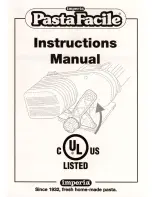
12 YEASTS
ACTIVE DRY YEAST
Yeast through a fermentation process produces gas (carbon dioxide) necessary to make the bread rise. Yeast must
be able to feed on sugar and flour carbohydrates in order to produce this gas. Active dry granular yeast is used
in all recipes that call for yeast. There are basically three different types of yeast available, fresh, dry and instant
quick rising. It is recommended that traditional dry yeast be used, however, instant quick rising can also be used
in lesser amounts. (Note: The recipes in this cookbook were developed using traditional dry yeast), Fresh or
compressed cake yeast is not recommended as they will produce poor results. Yeast must always be stored in a
refrigerator to keep it fresh. Too much heat will kill it. Ensure your yeast is fresh by checking its expiration date.
Once a package or can of yeast is opened it is important that the remaining contents be immediately resealed and
refrigerated as soon as possible for future use. Often bread or dough, which fails to rise, is due to stale yeast being
used. The following test can be used to determine whether your yeast is stale and inactive:
A) Place l/2 cup of lukewarm water into a small bowl or cup.
B) Stir 1 tsp. of sugar into the water then sprinkle 2 tsp. of yeast over the surface.
C) Place bowl or cup in a warm area and allow to sit for 10 minutes undisturbed.
D) The mixture should foam and produce a strong yeast aroma.
If this does not occur, fresh yeast should be purchased.
CONVERSION CHART FOR FAST-RISING YEAST
1 1/2 Teaspoons active dry yeast = 1 teaspoon fast-rising yeast
2 1/2 Teaspoons active dry yeast = 1 l/2 teaspoon fast-rising yeast
3 Teaspoons active dry yeast = 1 3/4 teaspoon fast-rising yeast
Note:
1. 1 Teaspoon equivalent to 5ml.
2. 1 Tablespoon equivalent to 15ml.
13 SUGAR
Sugar is important for the colour and flavour of breads. It is also food for the yeast as it supports the fermentation
process. Recipes in this cook book that call for sugar require granulated sugar. Do not substitute powdered sugar
or brown sugar unless indicated. Artificial sweeteners cannot be used as a substitute for sugar as the yeast
will not react properly with them.
14 SALT
Salt is necessary to balance the flavour of breads and cakes, as well as for the crust colour that develops during
baking. Salt also limits the growth of yeast so the amounts shown in the recipes should not be increased. For dietary
reasons it may even be eliminated entirely, however, your bread may over-proof and rise higher than normal.
15 LIQUIDS
Liquids such as milk (l%, 2%, whole & skim) or a combination of powdered milk and water, can be used when
making bread. Milk will improve flavour, provide a velvety texture and soften the crust, while water alone will produce
a crispier crust, Some liquids call for juice (orange, apple, etc.) to be added as a flavour enhancer.
16 EGGS
Eggs add richness and a velvety texture to bread doughs and cakes. Use large-size eggs in these recipes.
17 SHORTENING, BUTTER & MARGARINE
Shortening, Butter and Margarine "shortens" or tenderises the texture of yeast breads. French Bread gets its unique
crust and texture from the lack of butter added. However, breads that call for butter stay fresh longer. If butter or
margarine is used direct from the refrigerator, it should be cut into small pieces for easier blending during the
kneading cycle. Oil should not be used as a substitute for butter, margarine or shortening.
TIPS ON USING YOUR BREADMAKER
15
















































